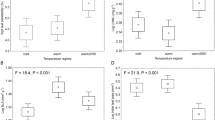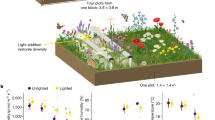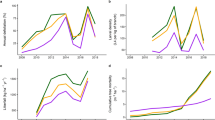Abstract
Current theories on plant–herbivore interactions suggest that plant species of different successional status and leaves of various ages differ in their degree of ephemerality and predictability to herbivores, and will therefore exhibit different anti-herbivore characteristics1–6. Old leaves and leaves of mature forest plants are expected to be better defended than ephemeral young leaves and leaves of early successional plants. These predicted patterns of plant defence and the resultant patterns of insect grazing are not well documented for natural communities. Field studies have shown that mammalian herbivores in a tropical forest prefer young leaves7 and that insect grazing in a temperate forest is heaviest on the young leaves8. Laboratory studies have shown that late successional species9,12 or plants with certain chemical defences13–17 are less palatable for generalist herbivores. Laboratory results depend, however, on the particular herbivore tested, and may not accurately predict rates of herbivory in natural systems. Here I report on rates of herbivory on young and mature leaves from tree species with different life history patterns. Grazing rates (% leaf area eaten per day) on mature leaves of fast growing, shade-intolerant species (pioneers) were an order of magnitude greater than those on slow growing, shade-tolerant species (persistents). Young leaves in both groups of species suffered significantly greater grazing damage than mature leaves.
This is a preview of subscription content, access via your institution
Access options
Subscribe to this journal
Receive 51 print issues and online access
$199.00 per year
only $3.90 per issue
Buy this article
- Purchase on Springer Link
- Instant access to full article PDF
Prices may be subject to local taxes which are calculated during checkout
Similar content being viewed by others
References
Gates, R. G. & Rhoades, D. F. Biochem. Syst. Ecol 5, 185–193 (1977).
Feeny, P. P. in Coevolution of Animals and Plants (eds Gilbert, L. E. & Raven, P. H.) 3–19 (University of Texas Press, Austin, 1975); in Biochemical Interaction Between Plants and Insects (eds Wallace, J. W. & Mansell, R. L.) 1–40 (Plenum, New York, 1976).
Rhoades, D. F. & Gates, R. G. in Biochemical Interaction Between Plants and Insects (eds Wallace, J. W. & Mansell, R. L.) 168–213 (Plenum, New York, 1976).
Rhoades, D. F. in Herbivores: Their Interrelationships with Plant Secondary Constituents (eds Rosenthal, G. A. & Janzen, D. H.) 3–54 (Academic, New York, 1979).
Feeny, P. P. Ecology 51, 565–581 (1970).
Dement, W. A. & Mooney, H. A. Oecologia 15, 65–76 (1974).
Milton, K. Am. Nat. 114, 362–378 (1979).
Reichle, D. E., Goldstein, R. A., Van Hook, R. I. & Dodson, G. J. Ecology 54, 1076–1084 (1973).
Gates, R. G. & Orians, G. H. Ecology 56, 410–418 (1975).
Freeland, W. J. & Winter, J. W. J. chem. Ecol. 1, 439–455 (1975).
Grime, J. P., MacPherson-Stewart, S. F. & Dearman, R. S. J. Ecol. 56, 405–420 (1968).
Otte, D. Oecologia 18, 129–144 (1975).
Bernays, E. A. & Chapman, R. F. Ecol. Ent. 2, 1–18 (1977).
Cooper-Driver, G. A. & Swain, T. Nature 260, 604 (1976).
Gates, R. G. Ecology 56, 391–400 (1975).
Feeny, P. P. J. Insect Phys. 14, 805–817 (1968).
Jones, D. A. in Phytochemical Ecology (ed. Harborne, J. B.) 103–124 (Academic, New York, 1972).
Hartshorn, G. S. in Tropical Trees as Living Systems (eds Tomlinson, P. B. & Zimmerman, M. H.) 617–638 (Cambridge University Press, Cambridge, Mass. 1978).
Aubreville, A. in World Vegetation Types (ed. Eyre, S. R.) 41–55 (Columbia University Press, New York, 1971).
Whitmore, T. C. Tropical Rain Forests of the Far East (Clarendon, Oxford, 1975); in Tropical Trees as Living Systems (eds Tomlinson, P. B. & Zimmerman, M. H.) 639–655 (Cambridge University Press, 1978).
Bray, J. R. Ecology 37, 598–600 (1956).
Schulz, J. P. Verh. K. Ned. Akad. Wet. Afd. natuurkd Tweed. Reeks. 53, 1–367 (1960).
van Steenis, C. G. G. J. Proc. Kandy Symp. on Study of Trop. Veg. 159–163 (UNESCO, Paris, 1956).
McKey, D. Science 202, 61–64 (1978).
Oates, J. F., Swain, T. & Zantovska, J. Biochem. Syst. Ecol. 5, 317–321 (1977).
Dixon, A. F. G. in Animal Populations in Relation to Their Food Resources (ed. Watson, A.) 271–287 (Br. Ecol. Soc., London 1970).
Oelberg, K. J. Range Mgmt 9, 220–225 (1956).
Rhoades, D. F. Biochem. Syst. Ecol. 5, 281–290 (1977); in The Biology and Chemistry of the Creosotebush in New World Deserts (eds Mabry, T. J., Hunziker, J. & DiFeo, D. R.) 135–175 (Dowden, Hutchinson and Ross, Stroudsburg, 1977).
Janzen, D. H. Ecology 52, 964–979 (1971).
McKey, D. Am. Nat. 108, 305–320 (1974).
Knight, D. H. Ecol. Monogr. 45, 259–284 (1975).
Author information
Authors and Affiliations
Rights and permissions
About this article
Cite this article
Coley, P. Effects of leaf age and plant life history patterns on herbivory. Nature 284, 545–546 (1980). https://doi.org/10.1038/284545a0
Received:
Accepted:
Issue Date:
DOI: https://doi.org/10.1038/284545a0
This article is cited by
-
Soil sterilization and fertility impacts on urease and belowground mass specific phosphatase activity vary among Chinese tallow tree (Triadica sebifera) populations
Plant Ecology (2022)
-
Intraspecific variation of reproductive traits between migratory and resident populations of the rice plant skipper Parnara guttata guttata
Evolutionary Ecology (2021)
-
Plant apparency drives leaf herbivory in seedling communities across four subtropical forests
Oecologia (2021)
-
Herbivory in Seagrass Meadows: an Evolving Paradigm
Estuaries and Coasts (2021)
-
Oviposition by the vagrant eriophyoid mite Aculops allotrichus on leaves of black locust tree, Robinia pseudoacacia
Experimental and Applied Acarology (2019)
Comments
By submitting a comment you agree to abide by our Terms and Community Guidelines. If you find something abusive or that does not comply with our terms or guidelines please flag it as inappropriate.



